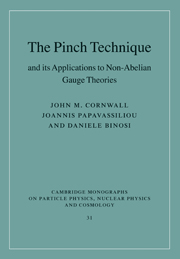Book contents
- Frontmatter
- Contents
- Introduction: Why the pinch technique?
- 1 The pinch technique at one loop
- 2 Advanced pinch technique: Still one loop
- 3 Pinch technique to all orders
- 4 The pinch technique in the Batalin–Vilkovisky framework
- 5 The gauge technique
- 6 Schwinger–Dyson equations in the pinch technique framework
- 7 Nonperturbative gluon mass and quantum solitons
- 8 Nexuses, sphalerons, and fractional topological charge
- 9 A brief summary of d = 3 NAGTs
- 10 The pinch technique for electroweak theory
- 11 Other applications of the pinch technique
- Appendix: Feynman rules
- Index
10 - The pinch technique for electroweak theory
Published online by Cambridge University Press: 04 February 2011
- Frontmatter
- Contents
- Introduction: Why the pinch technique?
- 1 The pinch technique at one loop
- 2 Advanced pinch technique: Still one loop
- 3 Pinch technique to all orders
- 4 The pinch technique in the Batalin–Vilkovisky framework
- 5 The gauge technique
- 6 Schwinger–Dyson equations in the pinch technique framework
- 7 Nonperturbative gluon mass and quantum solitons
- 8 Nexuses, sphalerons, and fractional topological charge
- 9 A brief summary of d = 3 NAGTs
- 10 The pinch technique for electroweak theory
- 11 Other applications of the pinch technique
- Appendix: Feynman rules
- Index
Summary
In this chapter, we give a general overview of how the pinch technique (PT) is modified in the case of a theory with spontaneous (tree level) symmetry breaking (Higgs mechanism), using the electroweak sector of the standard model as the reference theory.
The application of the pinch technique in the electroweak sector brings about significant conceptual and practical advantages. First, from the purely theoretical point of view, it is important to know that the PT construction is sufficiently general to encompass theories other than massless Yang–Mills. Though the required technical manipulations in the electroweak sector turn out to be fairly cumbersome, the basic underlying principles are practically the same; what increases the complexity is not the principle itself but rather the proliferation of fields and vertices involved. In addition, the PT algorithm exposes systematically the vast number of cancellations that take place when the (nonrenormalizable) Green's functions of the unitary gauge are put together to form physical amplitudes. In fact, one may start directly from the unitary gauge and derive the same PT Green's function constructed in the context of the (renormalizable) Rξ gauges. The application of the pinch technique provides a deeper understanding of the connection between the unitary gauge and the optical theorem and analyticity. Moreover, in the context of a theory with symmetry breaking, one gains new, important insights on the connection between the pinch technique and the background field method (BFM).
- Type
- Chapter
- Information
- Publisher: Cambridge University PressPrint publication year: 2010



